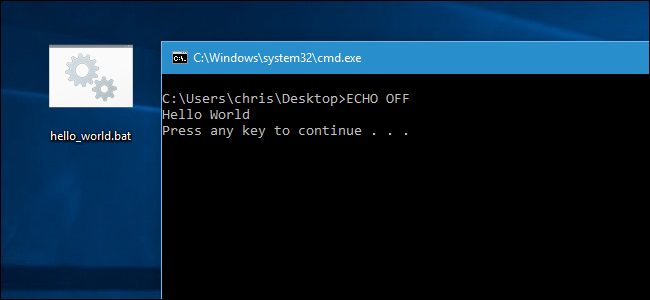In this article, we will see how to get a useful context menu item to create a New -> Batch file. It will save you time if you need to create them from time to time. You get a new file with the BAT extension instantly with one click.
Usually, to create a new batch file, you can either create a new text file and rename its extension every single time to.bat or.cmd, or you can use Notepad. Using Notepad, it is possible to save the entered text as a batch file by selecting the File - Save menu item and typing the filename with the bat extension in quotes. SO:Long commands split over multiple lines in Vista/DOS batch (.bat) file SO:How does the Windows Command Interpreter (CMD.EXE) parse scripts? Edit: Avoid echo. This doesn't answer the question, as the question was about single echo that can output multiple lines. Mar 06, 2020 The percent followed by a numeric value, beginning with one, allows you to add matched variables to a batch file. The line below is an example of what can be used in a batch file. ECHO Hello%1. With a batch file containing the above line if you type myname (name of bat file) and then your name, as shown below.
Usually, to create a new batch file, you can either create a new text file and rename its extension every single time to .bat or .cmd, or you can use Notepad. Using Notepad, it is possible to save the entered text as a batch file by selecting the File - Save menu item and typing the filename with the bat extension in quotes. It is necessary to add quotes to save it with the correct extension.
Instead, the New -> Batch file menu item is more useful. To get it working, apply the following simple Registry tweak.


- Open Registry Editor.
- Go to the following Registry key:
Tip: You can access any desired Registry key with one click.
- Create a new subkey here named 'ShellNew'. You will get
- Under the ShellNew subkey, create a new string value named NullFile. Don't set its value data, leave it empty. This value indicates that Windows should create an empty file without any content.
- Again, under the ShellNew subkey, create a new string named ItemName. Set its value to the following string:
You will get the following:
Now, open the context menu of any folder. You can just right click the empty space on your Desktop. It will have a new item in the 'New' context menu:

Once you click it, a new empty *.bat file will be created:
The next time you need to create a batch file, you can use this context menu item to save your time. You can use the same trick to create a .cmd file.
The same can be done using Winaero Tweaker. Go to Context Menu -> 'New' Menu in File Explorer:
Use this option to avoid Registry editing.
What Is A Batch File And Batch Job? - Computer Hope
Also, I made ready-to-use Registry files, so you can avoid manual Registry editing. An undo file is also included.
That's it. This tricks works in Windows 7, Windows 8 and Windows 10. It should work in older Windows versions too.
Advertisment
Batch File Add To Path
Thank you for this info, but as Swaminathan.vp stated, once you have a vbs file it's best to just call it directly from the batch file. I assume then that the Yes / No button responses are specified within the batch file?
My main question is this: How do I display the red exclamation mark warning shield icon in the dialogue box (or any red exclamation mark) as well as being able to specify whether you want Yes/No, Ok/cancel, etc as it looks from what you've written above like you have to have one or the other, which I'm surely isn't the case. Also, the number you specified for 'Warning query icon' doesn't work...
Please could you supply a few examples of working batch file script that demonstrates a few of the possibilities, and how to apply actions for clicking on Yes/No, Ok/cancel, etc?